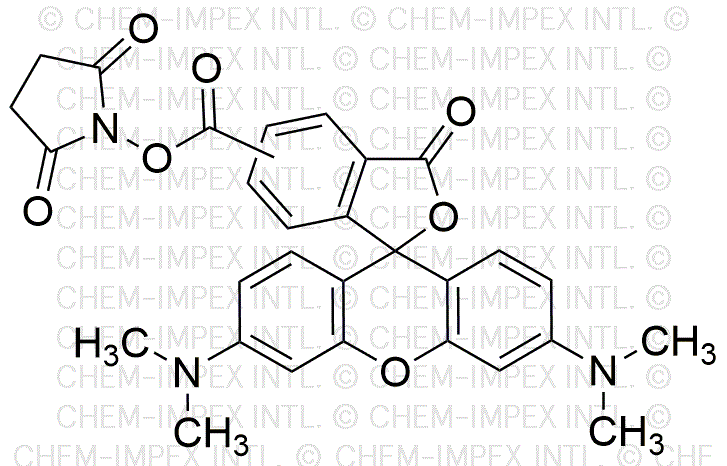5(6)-Carboxytetramethylrhodamine N-succinimidyl ester is widely utilized in research focused on:
- Fluorescent Labeling: This compound is commonly used to label proteins and antibodies in biological research, allowing scientists to visualize and track cellular processes under a fluorescence microscope.
- Cell Imaging: It plays a crucial role in live-cell imaging applications, enabling researchers to monitor dynamic biological events in real-time, which is essential for understanding cellular behavior and interactions.
- Flow Cytometry: The compound is employed in flow cytometry for the analysis of cell populations. Its fluorescent properties help distinguish between different cell types, aiding in immunology and cancer research.
- Drug Delivery Systems: It can be integrated into drug delivery systems, where its fluorescent characteristics help in tracking the distribution and release of therapeutic agents within biological systems.
- Diagnostic Applications: This chemical is utilized in the development of diagnostic assays, particularly in detecting specific biomolecules, enhancing the sensitivity and specificity of tests in clinical settings.
Informations générales
Propriétés
Sécurité et réglementation
Applications
5(6)-Carboxytetramethylrhodamine N-succinimidyl ester is widely utilized in research focused on:
- Fluorescent Labeling: This compound is commonly used to label proteins and antibodies in biological research, allowing scientists to visualize and track cellular processes under a fluorescence microscope.
- Cell Imaging: It plays a crucial role in live-cell imaging applications, enabling researchers to monitor dynamic biological events in real-time, which is essential for understanding cellular behavior and interactions.
- Flow Cytometry: The compound is employed in flow cytometry for the analysis of cell populations. Its fluorescent properties help distinguish between different cell types, aiding in immunology and cancer research.
- Drug Delivery Systems: It can be integrated into drug delivery systems, where its fluorescent characteristics help in tracking the distribution and release of therapeutic agents within biological systems.
- Diagnostic Applications: This chemical is utilized in the development of diagnostic assays, particularly in detecting specific biomolecules, enhancing the sensitivity and specificity of tests in clinical settings.
Documents
Fiches de données de sécurité (FDS)
La FDS fournit des informations de sécurité complètes sur la manipulation, le stockage et l’élimination du produit.
Spécifications du produit (PS)
Le PS fournit une description complète des propriétés du produit, notamment sa composition chimique, son état physique, sa pureté et les exigences de stockage. Il détaille également les plages de qualité acceptables et les applications prévues du produit.
Certificats d'analyse (COA)
Recherchez des certificats d'analyse (COA) en saisissant le numéro de lot du produit. Les numéros de lot et de lot se trouvent sur l'étiquette d'un produit, après les mots « Lot » ou « Lot de fabrication ».
Numéro de catalogue
Numéro de lot/série
Certificats d'origine (COO)
Ce certificat d'exploitation confirme le pays dans lequel le produit a été fabriqué, et détaille également les matériaux et composants utilisés et s'il est issu de sources naturelles, synthétiques ou autres sources spécifiques. Ce certificat peut être requis pour les douanes, le commerce et la conformité réglementaire.
Numéro de catalogue
Numéro de lot/série
Fiches de données de sécurité (FDS)
La FDS fournit des informations de sécurité complètes sur la manipulation, le stockage et l’élimination du produit.
DownloadSpécifications du produit (PS)
Le PS fournit une description complète des propriétés du produit, notamment sa composition chimique, son état physique, sa pureté et les exigences de stockage. Il détaille également les plages de qualité acceptables et les applications prévues du produit.
DownloadCertificats d'analyse (COA)
Recherchez des certificats d'analyse (COA) en saisissant le numéro de lot du produit. Les numéros de lot et de lot se trouvent sur l'étiquette d'un produit, après les mots « Lot » ou « Lot de fabrication ».
Numéro de catalogue
Numéro de lot/série
Certificats d'origine (COO)
Ce certificat d'exploitation confirme le pays dans lequel le produit a été fabriqué, et détaille également les matériaux et composants utilisés et s'il est issu de sources naturelles, synthétiques ou autres sources spécifiques. Ce certificat peut être requis pour les douanes, le commerce et la conformité réglementaire.


